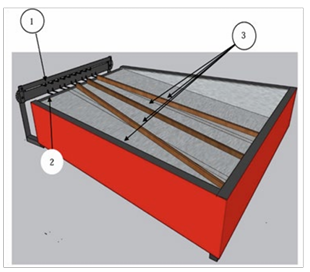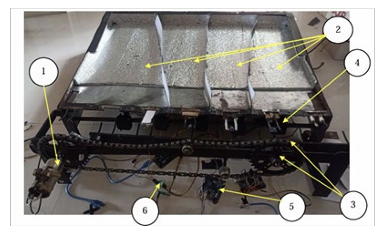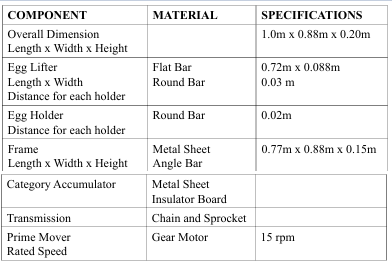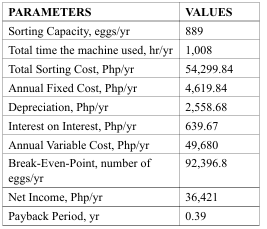Research Article - (2025) Volume 3, Issue 3
Design Optimization and Evaluation of an Egg Sorting Machine Using Arduino Uno Microcontroller
2Department of Agricultural and Biosystems Engineering, College of Engineering, Central Luzon State , Philippines
Received Date: Jan 31, 2025 / Accepted Date: Mar 03, 2025 / Published Date: Mar 20, 2025
Copyright: ©2025 Herald Kam G. Hernando, et al. This is an open-access article distributed under the terms of the Creative Commons Attribution License, which permits unrestricted use, distribution, and reproduction in any medium, provided the original author and source are credited.
Citation: Bravo Jr, J. G., Echanique, M. C., Laureano, A. G., Solaina, V. B., Hernando. H. K. G., et al, (2025). Optimization and Evaluation of an Impact-Type Cacao Bean Huller: A Design and Fabrication Approach. Eng OA, 3(3), 01-05.
Abstract
An egg sorting machine using a weight sensor was developed using low-cost, locally available materials and local manufacturing technologies to sort eggs into different sizes based on weight. The fabricated machine comprises several parts, including the transmission, transporting, and sorting mechanisms. The transporting mechanism is powered by a 15 RPM, 12V gear motor, chain, and sprocket for the transmission unit. The weighing and sorting unit used the Servo motor, Arduino Uno Microcontroller, and Load Cell with HX711 amplifier. Performance test results for the 360 table egg samples show that the egg sorting machine has an average sorting accuracy of 93.88% with a capacity of 889 table eggs per hour (4.05 seconds per egg). It shows that the machine is accurate. Thus, the machine reduces the use of manpower and drudgery of manual sorting while maintaining a higher accuracy and speed in sorting table eggs. It can be used in egg-laying farms to classify small, medium, large, and extra-large sizes. The annual income is Php 36, 421 and in 1 008 hours a year of sorting eggs, the machine was expected to meet its break-even period of 92,396.8 eggs per year, and it will reach its payback period after 0.39 years.
Keywords
Weight Sensor, Chicken Eggs, Sorting, Microcontroller, Grading
Introduction
Chicken eggs were significant functional foods as they contained substances providing physiological benefits beyond basic nutritional needs. From a different perspective, the quality of eggs was essential, creating the need for egg sorting. Sorting helped promote consistent packaging, pricing, and quality assurance for consumers. Traditionally, sorting was mostly done by manually weighing chicken eggs on a scale. Small-scale egg farm laborers, in particular, continued using manual methods, which required careful handling to avoid shattering or breaking eggs. Without a digital weighing scale, weighing became subjective, as weight readings depended on the observer. When analog weighing scales were used, errors in readings due to operator fatigue and judgment increased.
Moreover, as the volume of chicken eggs grew, the manual process became more costly and inefficient. In response to market competition, technological advancements and technical equipment for product manufacturing, sorting, and sales grew increasingly important. Sorting and packaging required significant investments in money and manpower. Manual sorting had two major drawbacks: inaccuracy and high labor costs. Automatic egg sorters were developed to address these issues inherent in the manual sorting method. Additionally, "scale-appropriate" agricultural machinery needed to be implemented to increase farmers' returns. The study’s general objective was to develop a sorting machine for chicken eggs. Specifically, it aimed to design a prototype sorting machine for chicken eggs using locally available materials, fabricate the prototype using local manufacturing technologies, test and evaluate the machine's performance in terms of accuracy and capacity, and conduct an economic analysis of the machine's use.
Materials and Methods
The egg sorting machine was developed to automatically sort chicken eggs according to their classification based on weight.
When Designing the Machine, the Following were Con sidered
a) suitable materials were selected for each machine component, prioritizing locally available materials. Parts in direct contact with the egg were made of soft materials to prevent cracking; b) welding and other fabrication processes used local manufacturing technologies; c) the machine was powered by an electric motor and designed to be operated by two people; d) detailed design of the machine’s components was completed, using Arduino Uno as it provided an open-source platform for hardware and software; e) ease of operation; and f) the accuracy and capacity of the machine to sort eggs, which aimed to surpass that of manual sorting.
Machine Design Conceptualization
The mechanical foundation of the chicken egg sorter machine was designed using SketchUp Pro 2021. The machine's design had to be approved based on material availability and cost considerations. Figure 1 showed the perspective view of the machine, including its components: (1) Egg Lifter, (2) Egg Holder, and (3) Egg Accumulator (Extra-large, Large, Medium, and Small).

Figure 1: Design of the Egg Sorting Machine
Working Principle
The chicken egg was manually loaded into the machine and introduced into the system in a timed manner. An Arduino Microcontroller and Load Cell with HX711 were used to automate the machine's sorting units. The egg’s weight was measured using the load cell connected to the HX711 driver to convert the analog signal into a digital one. This signal was sent to the Arduino Uno. Using Arduino software, the Arduino kit was programmed with a specific code for the system. Once the load cell determined the egg's weight, the egg was carried out of the load cell system with the help of the egg lifter. The egg lifter was powered by a 15 RPM gear motor connected to a chain drive mechanism. When the egg entered the sorting system, the signal activated the corresponding servo motor based on the programmed settings. The egg holder was installed at an angle, allowing the egg to roll down into the egg category accumulator.
Calibration (Pre- Testing)
Four load cells were utilized, each with an egg holder for stable egg weighing. Each egg holder had a different weight, so the load cells were calibrated, and their readings were reset to zero to exclude the weight of the egg holder, ensuring accurate weighing. The calibration process involved placing an object with a known weight in each egg holder and inputting the object's weight into the load cell program. This process was repeated for every load cell to ensure proper calibration.
Preparation of Sample Materials
One hundred twenty chicken eggs per test were used as the test material, with 30 eggs of each size classification (extra-large, large, medium, and small). Before testing, each egg was manually weighed using a digital weighing scale to confirm the correct classification of each egg sample. A total of 360 eggs were weighed across three different machine tests.
Method of Testing
The machine's accuracy and capacity were tested using three hundred sixty chicken eggs across three trials, with 120 eggs per trial and 30 eggs per size classification. The machine was programmed with the weight classification standard set by the Bureau of Agriculture and Fisheries Products Standards (BAFPS) of 2005. The samples were automatically sorted for each trial, and the time taken to sort 120 eggs was recorded. The data from automatic sorting was then evaluated. Three tests were conducted, with 120 chicken eggs selected for each trial. Samples were manually sorted by weight before being fed into the machine, and the machine's accuracy and capacity were assessed.
Data Collection
The following data were gathered during testing and evaluation to analyze and determine the machine's performance parameters: (a) Sorting Capacity: The machine's sorting capacity was calculated by dividing the total number of table eggs by the sorting time per sample, providing the number of eggs that could be sorted in one hour; (b) Sorting Accuracy: The performance of the automated chicken egg sorter in terms of accuracy was assessed according to the BAFPS table egg classification standards; (c) Weight Classification of Chicken Eggs: The classification of eggs was based on the Bureau of Agriculture and Fisheries Products Standards (2005). Although the released standard includes seven classifications, this study utilized four classifications: Small, Medium, Large, and Extra-Large.
Statistical Analysis
Three treatments with the same speed settings were used in the experiment (15 rpm). Data were analyzed using a comparison test to determine significant differences between the three trials. Data were computed and analyzed.
Simple Economic Analysis
ost analysis was a value engineering approach that aimed to widen the difference between a product's cost and value, considering expenditures such as parts, labor, and other items. An economic analysis was necessary to estimate the overall product benefit and adjust the costs and benefits to reflect their economic values accurately. Hunt (1995) provided the formula for calculating the machine's economic feasibility.
Results and Discussion
Description of the Machine
The egg sorting machine comprised several parts, including transmission, transporting, and sorting mechanisms. Figure 2 displayed the actual egg sorting machine and its components: (1) Gear Motor, (2) Category Accumulator, (3) Chain and Sprocket, (4) Egg Holder, (5) Arduino Uno, (6) HX711, (7) Load Cell, and (8) Servo Motor. The machine was developed and fabricated to efficiently sort chicken eggs by considering their basic properties, with the weight-based sorting properties informing the design of various components.

Figure 2: Prototype Egg Sorting Machine
The machine was fabricated in Amulung, Cagayan, and testing took place at Golden Harvest Subdivision. The performance of the developed egg-sorting machine was assessed in terms of its capacity and accuracy.
Operation of the Egg Sorting Machine
One person was required to operate the machine. Chicken eggs were manually loaded into the machine’s egg holder one at a time and introduced into the system in a timed manner. A 12V battery COMPONENT powered the gear motor, which transmitted power through the chain and sprocket system to rotate the egg lifter counterclockwise. The egg’s weight was measured using the load cell, which was connected to the HX711 driver to amplify the digital signal into a code sent to the Arduino Uno. After the weight was recorded, the servo motor pushed the egg into its relevant accumulator. If the egg was not correctly positioned for its classification, it was moved out of the load cell system by the egg lifter until it reached the designated classification.

Table 1: Machine Specifications
Performance Evaluation
One hundred twenty chicken egg samples were selected: thirty small, thirty medium, thirty large, and thirty extra-large. For three trials, the samples were sorted both manually and automatically. The program determined the size of each chicken egg based on preset weight ranges. Across the three trials, the machine achieved an average sorting accuracy of 93.88% and a sorting capacity of 889 eggs per hour. In the first accuracy test, the sorting machine achieved 91.67% accuracy, followed by 93.33% in test 2, and 96.67% in test 3, resulting in an average accuracy of 93.88%. For sorting speed, the machine sorted 120 chicken eggs in 488 seconds in test 1, 493 seconds in test 2, and 480 seconds in test 3, averaging 487 seconds (or 4.05 seconds per egg). This translated to an approximate sorting capacity of 889 chicken eggs per hour.

Table 2: Machine Performance Based On Accuracy and Capacity
According to an egg supplier in Amulung, Cagayan, they could typically sort approximately 600 chicken eggs per hour manually using a standard weighing scale. In comparison, the developed egg sorter was capable of sorting 889 chicken eggs per hour with higher accuracy. The machine thus saved time and reduced the labor involved in manual sorting.
The total fabrication cost for the machine was Php 14,214.9, as detailed in Table 4-7: Php 4,974 for materials, Php 1,740.9 for labor, Php 7,000 for system programming, and Php 500 for electricity. The annual depreciation was calculated at Php 2,558.68, with investment interest at Php 639.67, and repair and maintenance at Php 1,421.29, totaling Php 4,619.84 in fixed costs. The labor and machine costs were Php 49,680, leading to a total sorting cost of Php 54,299.84. The calculated sorting cost per egg was Php 0.05, with a breakeven volume of 92,396.8 eggs annually. The machine yielded a net income of Php 36,421.00 per year, with an expected payback period of 0.39 years.

Table 3: Economic Analysis of the Egg Sorter
Acknowledgement
We extend our heartfelt gratitude to Cagayan State University for providing the necessary resources and support throughout this study. Their commitment to fostering research and innovation has played a significant role in its completion.
Conclusion and Recommendations
This study aimed to design and develop a chicken egg sorting machine, conduct an economic analysis, and evaluate the machine's sorting capacity and accuracy. The researchers achieved all objectives, demonstrating that the machine could accurately identify and sort eggs by weight. The system’s overall sorting accuracy reached 93.88%, with a sorting capacity of 889 chicken eggs per hour, indicating high accuracy. Thus, the machine reduced the need for manual labor and the effort required for sorting while providing greater accuracy and speed in categorizing chicken eggs. This egg sorting machine can be used on egg-laying farms to classify eggs into small, medium, large, and extra-large sizes.
Based on the study's results and observations, the researchers recommend using the egg sorting machine in egg farms and poultry operations to innovate and improve egg processing. They suggest conducting pilot tests on poultry farms to evaluate the machine's acceptability among users and further refine its functionality. To enhance performance, the researchers recommend using lightweight materials, especially for egg lifters, to achieve smoother and more controlled rotation. Additionally, incorporating an egg feeder with an automatic egg stopper would allow for continuous feeding, making the process more convenient for the operator. Adding foam or other soft materials would also help secure the eggs and reduce the risk of breakage. Finally, optimizing the gear motor’s RPM for the egg lifters could significantly increase sorting speed.
References
1. Aragua, A., & Mabayo, V. Ä°. (2018). A cost-effective approach for chicken egg weight estimation through computer vision. International Journal of Agriculture Environment and Food Sciences, 2(3), 82-87.
2. Ab Nasir, A. F., Sabarudin, S. S., Majeed, A. P. A., & Ghani, A. S. A. (2018, April). Automated egg grading system using computer vision: Investigation on weight measure versus shape parameters. In IOP Conference Series: Materials Science and Engineering (Vol. 342, No. 1, p. 012003). IOP Publishing.
3. Alikhanov, J., Penchev, S. M., Georgieva, T. D., Moldazhanov, A., Kulmakhambetova, A., Shynybay, Z., ... & Daskalov, P. I. (2019). Design and performance of an automatic egg sorting system based on computer vision. TEM Journal, 8(4), 1319.
4. Authority, P. S. (2022). Chicken Egg Situation Report: October to December 2021. Retrieved from
5. Chen, X., Tian, H., Zou, L., & Wang, J. (2018). A dynamic weighing method for in-field eggs sorting using digital signal processor (DSP). In 2018 ASABE Annual International Meeting (p. 1). American Society of Agricultural and Biological Engineers.
6. Devasagayam, D., Shende, A., Gonsalves, A., Padalkar, K., & Rodrigues, V. (2019, December). Design and Development of Fruit Sorting and Packaging Machine. In International Conference on Industrial Engineering (Vol. 2, pp. 875-879).
7. Origines Jr, D. (2021). Load cell and Arduino technology as lemon fruit classifier. Available at SSRN 3793375.
8. Gaikwad, N. N., Samuel, D. V. K., Grewal, M. K., & Manjunatha, M. (2014). Development of orange grading machine on weight basis. Journal of Agricultural Engineering, 51(3), 1-8.
9. Harnsoongnoen, S., & Jaroensuk, N. (2021). The grades and freshness assessment of eggs based on density detection using machine vision and weighing sensor. Scientific Reports, 11(1), 16640.
10. Koranteng, Y. K., Kornu, J., Mensah, E., Gedel, W., & Aidoo, I. K. (2020). Design and Development of an Egg Collecting and Sorting System equipped with an HMI for Poultry Farms. In Proceedings of 6th UMaT Biennial International Mining and Mineral Conference.
11. Kumari, A., & Chawla, V. (2013). Automated Inspection and Grading of Vegetables Using Multisorting System Based on Embedded Platform. International Journal of Science and Research, 4(6), 1021-1026. 12. George, M. (2015). Multiple fruit and vegetable sorting system using machine vision. Int. J. Adv. Technol, 6(1), 1000142.
13. Molnár, S., & SzÅ?llÅ?si, L. (2020). Sustainability and quality aspects of different table egg production systems: A literature review. Sustainability, 12(19), 7884.
14. Narushin, V. G., Romanov, M. N., Lu, G., Cugley, J., & Griffin, D. K. (2020). Digital imaging assisted geometry of chicken eggs using Hügelschäffer's model. Biosystems Engineering, 197, 45-55.
15. Hernando, H. K., Rabanera, J. C., Bravo Jr, J. G., Echanique, M. C., Laureano, A. G., & Solaina, V. B. (2024). Design and Evaluation of an Egg Sorting Machine.
16. Philippine National Standard, PNS/BAFPS 35:2005, Table Egg-Specification
17. Quilloy, E. P., Suministrado, D. C., & Bato, P. M. (2018). Single-line automated sorter using mechatronics and machine vision system for Philippine table eggs. African Journal of Agricultural Research, 13(17), 918-926.
18. Reyes, J., & Sobejana, N. (2020). Development of Egg Classifier Using Pixy Camera and Load Cell. Available at SSRN 3717478.
19. Navarro, A. M., Reyes, C. M., & Francisco, K. A. (2021). UN common country assessment update for the Philippines (No. 2021-06). PIDS Discussion Paper Series.
20. Sebastian, C., & Rusli, L. P. (2021). Sorting Machine Based 0n Weight by Using Load Cell (Doctoral dissertation, Swiss German University). 21. Wang, S., Wu, M., & Wu, C. (2017). Design and test of automatic control system for egg electronic weighing and grading packaging production line. Transactions of the Chinese Society of Agricultural Engineering, 33(3), 265-271.
22. Lima, H. J. D., & Souza, L. A. Z. (2018). Vitamin A in the diet of laying hens: enrichment of table eggs to prevent nutritional deficiencies in humans. World's Poultry Science Journal, 74(4), 619-626.
23. Yao, Y., & Zhigang, X. (2016). Poultry Egg Body Defect Detecting and Sorting System based on Image Processing. International Journal of Simulation--Systems, Science & Technology, 17(13).
24. Zaheer, K. (2015). An updated review on chicken eggs: production, consumption, management aspects and nutritional benefits to human health. Food and Nutrition Sciences, 6(13), 1208.



